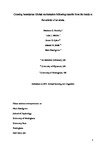Crossing boundaries: Global reorientation following transfer from the inside to the outside of an arena
| dc.contributor.author | Buckley, M | |
| dc.contributor.author | Holden, L | |
| dc.contributor.author | Spicer, Stuart | |
| dc.contributor.author | Smith, Alastair | |
| dc.contributor.author | Haselgrove, M | |
| dc.date.accessioned | 2019-02-13T10:08:16Z | |
| dc.date.issued | 2019-07 | |
| dc.identifier.issn | 2329-8464 | |
| dc.identifier.issn | 2329-8464 | |
| dc.identifier.uri | http://hdl.handle.net/10026.1/13296 | |
| dc.description | No embargo required | |
| dc.description.abstract |
In two spatial navigation experiments, human participants were asked to find a hidden goal (a Wi-Fi signal) that was located in one of the right-angled corners of a kite-shaped (Experiment 1) or a cross-shaped (Experiment 2) virtual environment. Goal location was defined solely with respect to the geometry of the environment. Following this training, in a test conducted in extinction, participants were placed onto the outside of the same environments and asked to locate the Wi-Fi signal. The results of both experiments revealed that participants spent more time searching in regions on the outside of the environments that were closest to where the Wi-Fi signal was located during training. These results are difficult to explain in terms of analyses of spatial navigation and re-orientation that emphasize the role of local representational encoding or view matching. Instead, we suggest that these results are better understood in terms of a global representation of the shape of the environment. | |
| dc.format.extent | 322-337 | |
| dc.format.medium | Print-Electronic | |
| dc.language | en | |
| dc.language.iso | en | |
| dc.publisher | American Psychological Association | |
| dc.subject | spatial learning | |
| dc.subject | geometric module | |
| dc.subject | associative learning | |
| dc.subject | navigation | |
| dc.subject | environmental boundary | |
| dc.title | Crossing boundaries: Global reorientation following transfer from the inside to the outside of an arena | |
| dc.type | journal-article | |
| dc.type | Journal Article | |
| plymouth.author-url | https://www.webofscience.com/api/gateway?GWVersion=2&SrcApp=PARTNER_APP&SrcAuth=LinksAMR&KeyUT=WOS:000474245000006&DestLinkType=FullRecord&DestApp=ALL_WOS&UsrCustomerID=11bb513d99f797142bcfeffcc58ea008 | |
| plymouth.issue | 3 | |
| plymouth.volume | 45 | |
| plymouth.publication-status | Published online | |
| plymouth.journal | Journal of Experimental Psychology: Animal Learning and Cognition | |
| dc.identifier.doi | 10.1037/xan0000206 | |
| plymouth.organisational-group | /Plymouth | |
| plymouth.organisational-group | /Plymouth/Faculty of Health | |
| plymouth.organisational-group | /Plymouth/Faculty of Health/Peninsula Medical School | |
| plymouth.organisational-group | /Plymouth/Faculty of Health/School of Psychology | |
| plymouth.organisational-group | /Plymouth/REF 2021 Researchers by UoA | |
| plymouth.organisational-group | /Plymouth/REF 2021 Researchers by UoA/UoA04 Psychology, Psychiatry and Neuroscience | |
| plymouth.organisational-group | /Plymouth/Research Groups | |
| plymouth.organisational-group | /Plymouth/Research Groups/Plymouth Institute of Health and Care Research (PIHR) | |
| plymouth.organisational-group | /Plymouth/Users by role | |
| plymouth.organisational-group | /Plymouth/Users by role/Academics | |
| plymouth.organisational-group | /Plymouth/Users by role/Researchers in ResearchFish submission | |
| dc.publisher.place | United States | |
| dcterms.dateAccepted | 2019-02-12 | |
| dc.rights.embargodate | 2019-12-20 | |
| dc.identifier.eissn | 2329-8464 | |
| dc.rights.embargoperiod | Not known | |
| rioxxterms.versionofrecord | 10.1037/xan0000206 | |
| rioxxterms.licenseref.uri | http://www.rioxx.net/licenses/all-rights-reserved | |
| rioxxterms.type | Journal Article/Review |


